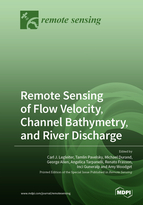Remote Sensing of Flow Velocity, Channel Bathymetry, and River Discharge
A special issue of Remote Sensing (ISSN 2072-4292). This special issue belongs to the section "Remote Sensing in Geology, Geomorphology and Hydrology".
Deadline for manuscript submissions: closed (15 February 2020) | Viewed by 63045
Special Issue Editors
Interests: remote sensing of rivers; fluvial geomorphology; hyperspectral; bathymetric LiDAR; depth retrieval; in-stream habitat; morphodynamics; channel change; geostatistics
Interests: global hydrology; inundation extent; lakes; rivers; wetlands; new satellite missions
Interests: remote sensing; hydrology; rivers; snow; water cycle
Interests: remote sensing of rivers; fluvial geomorphology; surface hydrology; water resources; carbon cycling
Interests: remote sensing of rivers; hydrological and hydraulic processes; flooded area estimation; analysis of climate change effects on flood frequency
Special Issues, Collections and Topics in MDPI journals
Interests: remote sensing of rivers; discharge estimation; inverse problems; hydrology; computer modeling; remote sensing of floods
Special Issues, Collections and Topics in MDPI journals
Interests: remote sensing of rivers; fluvial geomorphology; flooding; river channel dynamics; river biogeomorphodynamics; floodplain landscape evolution; spatiotemporal modeling
Interests: remote sensing of rivers; UAVs; structure-from-motion photogrammetry; grain size estimation; fluvial topography/bathymetry; refraction correction; fluvial geomorphology
Special Issue Information
Dear Colleagues,
River discharge is a fundamental hydrological quantity that summarizes how a watershed transforms the input of precipitation into output as streamflow. The accurate measurement of discharge is critical for numerous applications including water supply, navigation, recreation, management of in-stream habitat, and prediction and monitoring of floods and droughts. However, traditional, in situ stream gage networks providing such data are sparse and declining, even in developed nations, and absent in many parts of the world. Moreover, establishing and maintaining these gages is expensive, labor-intensive, and can place personnel at risk.
For all these reasons, remote sensing represents an appealing alternative means of obtaining streamflow information. Potential advantages of the remote sensing approach include greater efficiency, expanded coverage, increased measurement frequency, cost savings, reduced risk to field hydrographers, and the opportunity to examine not just isolated cross-sections but longer reaches of river channels in two or three dimensions. Realizing these objectives will require research focused on the remote measurement of river discharge and its components: flow velocity and channel geometry.
The purpose of this Special Issue is to stimulate progress toward an operational capacity for streamflow monitoring and advance novel methods for retrieving discharge and its components by encouraging studies on this topic and compiling high-quality, peer-reviewed articles in an issue of Remote Sensing dedicated to this theme. We encourage the submission of manuscripts concerned with all aspects of the remote measurement of streamflow, including estimation of flow velocity, channel bathymetry (or water depth), and discharge from various types of remotely-sensed data (active or passive) acquired from a range of platforms (manned or unmanned aircraft, satellites, or ground-based imaging systems). Papers describing past, present, or future missions devoted to fluvial remote sensing are welcome, with a submission deadline of 15 February 2020.
Dr. Carl J. Legleiter
Dr. Tamlin Pavelsky
Dr. Michael Durand
Dr. George Allen
Dr. Angelica Tarpanelli
Dr. Renato Frasson
Dr. Inci Guneralp
Dr. Amy Woodget
Guest Editors
Manuscript Submission Information
Manuscripts should be submitted online at www.mdpi.com by registering and logging in to this website. Once you are registered, click here to go to the submission form. Manuscripts can be submitted until the deadline. All submissions that pass pre-check are peer-reviewed. Accepted papers will be published continuously in the journal (as soon as accepted) and will be listed together on the special issue website. Research articles, review articles as well as short communications are invited. For planned papers, a title and short abstract (about 100 words) can be sent to the Editorial Office for announcement on this website.
Submitted manuscripts should not have been published previously, nor be under consideration for publication elsewhere (except conference proceedings papers). All manuscripts are thoroughly refereed through a single-blind peer-review process. A guide for authors and other relevant information for submission of manuscripts is available on the Instructions for Authors page. Remote Sensing is an international peer-reviewed open access semimonthly journal published by MDPI.
Please visit the Instructions for Authors page before submitting a manuscript. The Article Processing Charge (APC) for publication in this open access journal is 2700 CHF (Swiss Francs). Submitted papers should be well formatted and use good English. Authors may use MDPI's English editing service prior to publication or during author revisions.
Keywords
- Remote sensing of rivers
- discharge
- flow velocity
- channel bathymetry
- hydrology
- streamflow
- fluvial geomorphology













